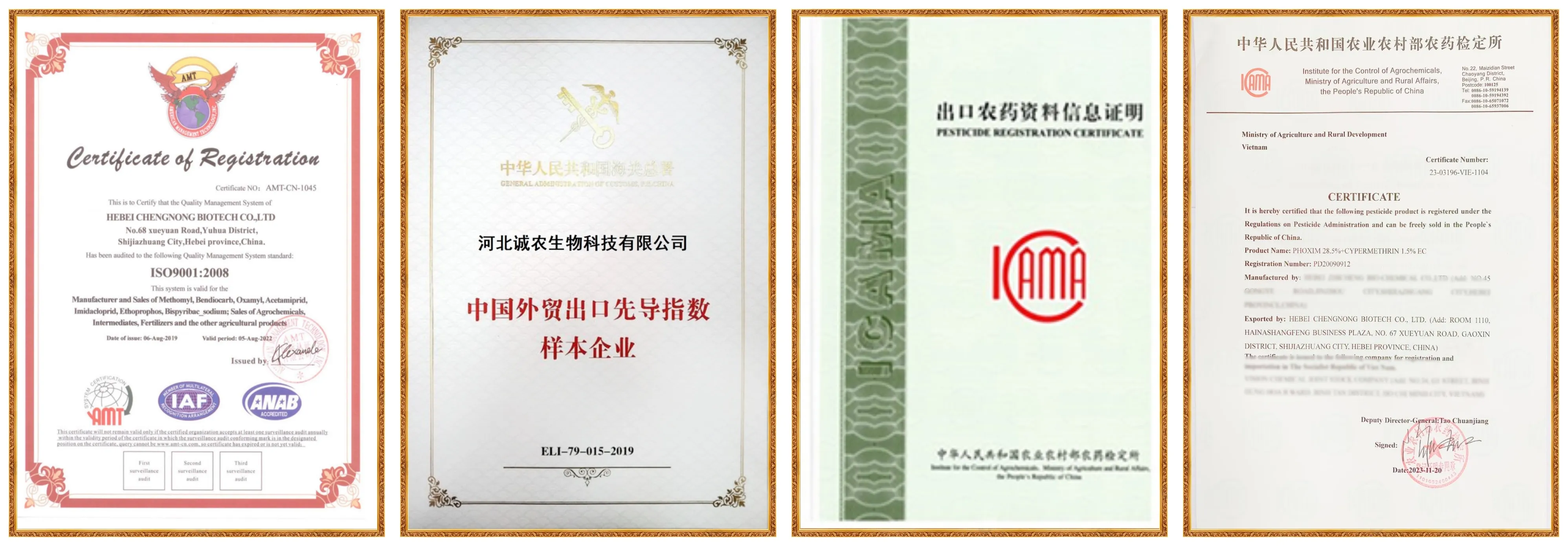
Nov . 09, 2024 07:48 Back to list
Exploring the Effects of Novaluron and Indoxacarb on Pest Management Strategies
Novaluron and Indoxacarb A Comprehensive Overview of Their Impact on Pest Management
In the realm of agricultural pest management, the evolution of insecticides is paramount to ensuring crop protection while minimizing environmental impact. Two notable insecticides that have gained attention in recent years are Novaluron and Indoxacarb. Each of these compounds belongs to different classes of insecticides and exhibits unique mechanisms of action, making them valuable assets in the ongoing struggle against pests.
Understanding Novaluron
Novaluron is categorized as an insect growth regulator (IGR). Specifically, it belongs to the family of benzoylureas. Its primary mode of action lies in interfering with the chitin synthesis process in insects. Chitin is an essential component of an insect’s exoskeleton, and by inhibiting its production, Novaluron effectively stunts the growth and development of juvenile insects. This action tends to be more effective against nymphs and larvae than against adult insects, making Novaluron particularly useful for targeting pest populations at their most vulnerable stages.
The use of Novaluron has been extensively researched for its potential in managing various crop-destroying pests, including caterpillars, aphids, and whiteflies. Because it disrupts the growth of insects rather than killing them outright, Novaluron has a relatively low toxicity profile for non-target organisms, including beneficial insects like pollinators. This feature holds significant importance in integrated pest management (IPM) strategies, where the maintenance of ecological balance is crucial.
Exploring Indoxacarb
On the other hand, Indoxacarb is classified as an oxadiazine insecticide. It operates via a different mechanism compared to Novaluron. Indoxacarb acts primarily as a neurotoxin by blocking sodium channels in the nerve cells of insects. When insects ingest Indoxacarb, it is converted into its active form, which then disrupts normal nerve function, leading to paralysis and ultimately death. This swift mode of action makes Indoxacarb effective against a broad range of pests, including various caterpillar species and some beetles.
novaluron indoxacarb

One of the key advantages of Indoxacarb is its low toxicity to mammals and birds, which enhances its safety profile for agricultural use. Additionally, Indoxacarb has a relatively short residual activity, which minimizes its environmental impact and facilitates the use of subsequent applications of other pest management strategies without significant chemical buildup.
Combining Novaluron and Indoxacarb
The integration of Novaluron and Indoxacarb within pest management programs can enhance effectiveness and sustainability. Novaluron controls the growth of pest populations by targeting their juvenile stages, reducing the number of reproductive adults over time. In contrast, Indoxacarb is effective against a wide array of adult pests, providing immediate relief from infestations. This complementary action can create a more robust defense mechanism, reducing the likelihood of pest resistance developing and prolonging the efficacy of insecticide applications.
Moreover, using both compounds in an integrated approach can help mitigate the risks associated with mono-cropping and overreliance on a single pest control method. By rotating and combining different modes of action, farmers can foster a more sustainable agricultural system that reduces the pressure on pest populations and supports ecological balance.
Conclusion
As the demand for sustainable agriculture grows, the role of innovative insecticides like Novaluron and Indoxacarb becomes increasingly important. Both compounds present unique advantages that can be leveraged in pest management strategies. By understanding their modes of action and potential applications, agriculture can move toward a future that emphasizes both productivity and environmental stewardship. Furthermore, ongoing research into their efficacy and ecological impacts will continue to shape the landscape of pest management, ensuring that crops are adequately protected while preserving the health of our ecosystems.
-
Emamectin Benzoate: AI-Optimized Pest Control Solution
NewsAug.01,2025
-
Best Abamectin 95% | Top Pesticide for Crop Protection
NewsJul.31,2025
-
Insecticide Spirotetramat 11% + Thiacloprid 11% SC at Good Price
NewsJul.30,2025
-
Best Abamectin SDS - Premium Quality & Reliable Safety Data
NewsJul.29,2025
-
Agrochemicals Pesticides Solutions for Sustainable Farming
NewsJul.29,2025
-
High-Quality Tebuconazole Fungicide for Crop Protection at Best Price
NewsJul.29,2025
